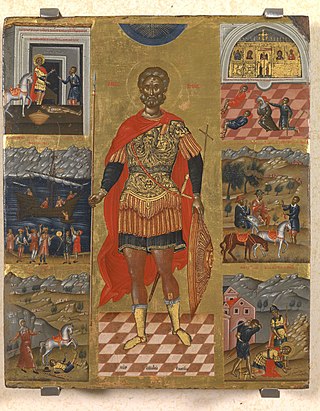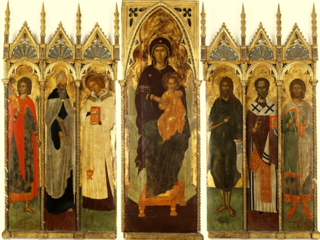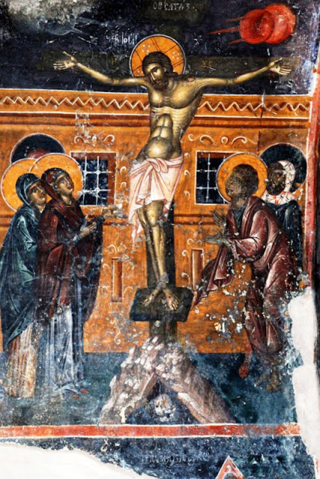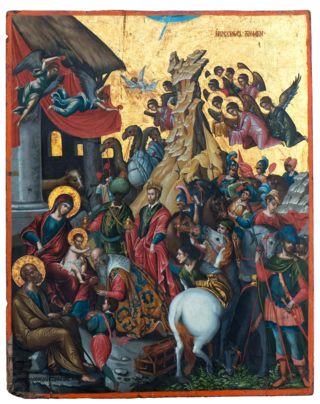
Heraklion or Herakleion, sometimes Iraklion, is the largest city and the administrative capital of the island of Crete and capital of Heraklion regional unit. It is the fourth largest city in Greece with a municipal population of 177,064 and 211,370 in its wider metropolitan area, according to the 2011 census.

Dominikos Theotokopoulos, most widely known as El Greco, was a Greek painter, sculptor and architect of the Spanish Renaissance. El Greco was a nickname, and the artist normally signed his paintings with his full birth name in Greek letters, often adding the word Κρής, which means "Cretan", in Ancient Greek.

View of Toledo, is one of the two surviving landscapes painted by El Greco, along with View and Plan of Toledo. View of Toledo is held by the Metropolitan Museum of Art in New York City.
The Baptism of Christ is an event described in the gospels of Matthew, Mark and Luke.

Dormition of the Virgin is a tempera painting on panel executed by El Greco near the end of his Cretan period, probably before 1567. El Greco's signature on the base of the central candelabrum was discovered in 1983. The discovery of the Dormition led to the attribution of three other signed works of "Doménicos" to El Greco and then to the acceptance as authentic of more works, signed or not.

Cretan School describes an important school of icon painting, under the umbrella of post-Byzantine art, which flourished while Crete was under Venetian rule during the Late Middle Ages, reaching its climax after the Fall of Constantinople, becoming the central force in Greek painting during the 15th, 16th and 17th centuries. The Cretan artists developed a particular style of painting under the influence of both Eastern and Western artistic traditions and movements; the most famous product of the school, El Greco, was the most successful of the many artists who tried to build a career in Western Europe, and also the one who left the Byzantine style farthest behind him in his later career.

The Historical Museum of Crete is a museum in Heraklion, Crete. It was founded by the Society of Cretan Historical Studies in 1953 and was originally housed in the former home of Minos Kalokairinos. The museum has since been expanded with a modern wing.

Angelos Akotantos was a Greek painter, educator, and protopsaltis. He painted icons in the maniera greca, at a time when that style was moving away from the traditions of the Byzantine Empire and towards the more refined aesthetic of the Cretan School. Akotantos taught painting to Andreas Pavias, Andreas Ritzos, and Antonios Papadopoulos, and his style influenced later artists such as Georgios Klontzas, Theophanes the Cretan, Michael Damaskinos and El Greco. Angelos's brother Ioannis was also a famous painter. There are 50 extant paintings reliably attributed to Akotantos, 30 of which bear his signature.

Saint Peter and Saint Paul is a painting by the Cretan-Spanish artist El Greco. The work was completed between 1590 and 1600. It is currently on display at the Museu Nacional d'Art de Catalunya, who purchased the work in 1932.

The Museum of El Greco is located on the edge of the village of Fodele in Crete, west of the city of Heraklion. It celebrates the mannerist painter El Greco, who grew up in the village.

The El Greco Museum is located in Toledo, Spain. It celebrates the mannerist painter El Greco, who spent much of his life in Toledo, having been born in Fodele, Crete.

The Immaculate Conception with St John the Evangelist is a c. 1585 oil on canvas painting of the Immaculate Conception by El Greco.

Christ Carrying the Cross is an oil painting by El Greco, produced early in his Toledo period circa de 1580. The picture depicts Christ in a moment of personal reflection as he carries the cross to his death, therefore committing the ultimate sacrifice for humankind. In the painting, Christ's eyes are lifted up to the heavens as he begins his walk towards his crucifixion. His gentle hands wrap around the cross as a stormy night floods the background. Christ Carrying the Cross is an oil painting, 105x79cm. The painting, one of numerous similar paintings by El Greco, is currently in the El Greco room in the New York art collection of the Metropolitan Museum of Art.
Paul Raison is a leading world specialist in the field of Old Master paintings. He was for many years a Chairman of the auction house Christie's.

Ieremias Palladas, also known as PouladasIeremia Pallada. He was a Greek Renaissance painter. He was a clergyman, painter, and educator. He was affiliated with Saint Catherine's Monastery in Mount Sinai, Egypt. He is one of the most notable Greek painters of the 17th century. His family consisted of clergy and painters. His nephew was Patriarch of Alexandria Gerasimos Palladas. His work was influenced by Nikolaos Tzafouris and Angelos Akotantos. Georgios Klontzas and Emmanuel Lambardos were active in Crete around the same period. Palladas influenced the works of Theocharis Silvestros, Iakovos Moskos, Ioannis Kornaros and Philotheos Skoufos. According to the Institute of Neohellenic Research, twenty-four of his works survived. His specialty was painting crosses for the iconostasis or templo. Most of his works are in Egypt.

Nikolaos Philanthropinos, also known as Nicolaos Philanthropenos and Nicolaus Filantropinó or Philastropino was a Greek Byzantine painter. He was active in Crete, Venice, and Constantinople. He was a very famous painter during the onset of the Italian Renaissance, the end of the Palaeologan Renaissance and the beginning of the Greek Renaissance. He worked with Venetian master Nicolaus Storlado. His contemporaries in Crete were Manuel Fokas and Ioannis Pagomenos. He brought the art of Constantinople to Venice and Crete. He influenced both Greek and Italian art. Artists he influenced include: Angelos Akotantos and Andreas Ritzos. He completed some mosaics for St Mark's Basilica in Venice.

Manuel Fokas, also known as Manuele Fuca, was a Greek Byzantine painter. Most of his frescos have survived until today. Three churches in Crete containing Fokas's frescos are Saint George, Emparaso, Agios Konstantinos Avdou, and Saint George Apano Symi. Artists from Heraklion that his work influenced include: El Greco, Georgios Klontzas and Michael Damaskinos.

The Last Supper is a tempera painting by Greek painter Michael Damaskinos. He painted in Heraklion, Sicily, Venice, and other parts of Italy. His painting of the Last Supper is considered the Greek Last Supper and is comparative to Leonardo da Vinci's masterpiece painted one hundred years prior. The two painters employed different painting styles but the subjects pose similarities. Damaskinos's painting features a feminine figure similar to that of Leonardo da Vinci's The Last Supper. The Damaskinos Last Supper is now in the Monastery of Agia Aikaterini in Heraklion, Crete. It is part of the collection of Saint Catherine's Monastery near Mount Sinai, Egypt.

Adoration of the Kings also known as the Adoration of the Magi is a popular tempera painting by Greek painter Michele Damaschino. The painting is roughly the same size as Damaschino's The Last Supper. Both paintings were created around the same period. Michele Damaschino painted in parts of Italy and Greece. He was primarily active in Heraklion, Sicily, and Venice. He is a major representative of the Cretan Renaissance. He was a Cretan Renaissance painter who painted in the Greek mannerisms prevalent at the time. He also blended the style with the Venetian technique creating a new prototype of painting. He was followed by countless artists both Greek and Italian. His version of the Adoration of the Kings is a very important painting because it reveals the mixture of painting styles prevalent in most of his works. The Adoration of the Kings is now in the Monastery of Agia Aikaterini in Heraklion, Crete. It is part of the collection of Saint Catherine's Monastery Mount Sinai, Egypt.
















